Space 1999 In The USA
The United States of America represents over half the world television market: for an expensive series like Space: 1999 success in this market was essential. American input was vital in order to sell what the U.S. television stations might see as a foreign import with no home interest. American stars such as the Landaus were the main attraction; American writers such as George Bellak and Art Wallace, and an American director like Lee H. Katzin were required to give the series an American perspective. The president of ITC New York, Abe Mandell, was involved from the beginning in casting, script approval and previewing episodes. For the second series, American writer and producer Fred Freiberger was employed to ensure an American viewpoint.
Lew Grade brought 60 US TV executives to Pinewood Studios to view a sneak preview in November 1974 (Variety 27 Nov 1974).
In March 1975, the film studio MGM filed suit in the Superior Court of California, Los Angeles to block ITC from using title "Space: 1999", as the series was regarded as being too close to their 1968 film 2001: A Space Odyssey. (Variety 31 March 1975, 9 April 1975). Fortunately for ITC the case was dismissed.
In the 1970s, American television was dominated by three big networks, ABC, CBS and NBC. These three companies produced most of the programming, and distributed it via their networks. Legally the networks could directly own only a maximum of 5 stations each ("O&O", owned and operated). Mostly the network was made up of affiliates, independently owned local stations who broadcast one of the three network's programming. Local markets were normally made up of one affiliate for each of the three networks, plus a number of completely independent stations.
Lew Grade's ITC had some success is selling to American networks, beginning with The Adventures of Robin Hood in 1955 on CBS, and including Gerry Anderson's Fireball XL5, on NBC in 1963, and Danger Man (as Secret Agent) on ABC in 1964. They would sell The Zoo Gang to NBC in July 1975, and the miniseries Moses the Lawgiver to CBS in June 1975. Later, in 1977, his Jesus of Nazareth would also be shown on NBC.
However, they also sold directly to stations, particularly older series. Network affiliates needed series to show outside of network content (which was legally restricted by the Federal Communications Commission, FCC). Independents needed content to compete.
In July 1973, ITC's Abe Mandell was telling Hollywood Reporter that Space: 1999 would be offered for syndication. ITC could sell the show in syndication, but that required an expensive sales operation and earned back the money unevenly over a lengthy period. At the same time, Mandell and Gerry Anderson were also pitching in directly to the three big US TV networks. A network sale would be promoted nationally, as well as making more money for ITC. Network executives seemed receptive to a new science fiction series, particularly CBS. Martin Landau and Barbara Bain would be cast to appeal to CBS, and later publicity announced it was "produced for network television", a commitment also made privately to the Landaus.
Landau and Bain were recruited and moved to London to begin filming. ITC was still pitching the show to the networks, but their initial interest had drained away (see private correspondence January 1974, March 1974 and still in December 1974).
The series was thus denied the simplicity of a network contract, with a single sales promotion and a nationwide broadcast. The lack of interest on the part of the networks may have had several reasons. Politics was one: they would have been unwilling to take such a prestigious independent production, particularly when it wasn't even American, in preference to their own, network produced, programming. An ITC spokesman explained to a newspaper "It's all shot in England, far out of reach, and they didn't like that idea. Besides, they were afraid of Bain and Landau because of all the bad publicity when they left Paramount [after Mission Impossible]"
A Lew Grade quote in Variety, 10 September 1975 states that the networks were unimpressed when he showed a rough cut ("sans music, colour correction, etc").
Science fiction was expensive and the networks had their own adventure series that seemed to satisfy the public interest. While Planet of the Apes was looking a strong prospect for CBS, ABC already had its own hit series The Six Million Dollar Man, while NBC had just finished its own Search and would later have The Invisible Man with David McCallum. Science fiction was an unproven genre on television. The only popular series had been Star Trek - a success it only earned in repeats. Star Wars and the flood of science fiction films were not to arrive until 1977. In 1977 there was Logan's Run, Man From Atlantis and The Fantastic Journey, followed by Battlestar Galactica (1978), The Incredible Hulk (1978) and Buck Rogers in the 25th Century (1979).
ITC preferred to film the entire 24 episode series before broadcast. This ensured they had a full series to sell world-wide. The US networks wanted to see audience reactions, first with a pilot, then run a half-season of 12-15 episodes, and either adjust the series, or cancel it. In 1975, Martin Landau pointed to the CBS Planet of the Apes TV series, which was cancelled after a half-season; UK television bought 24 episodes but only got 14. The US networks agreed on the ITC Biblical series such as Moses the Lawgiver and Jesus of Nazareth, because advertising sponsors were willing to fund them.
Initially the series was to premiere in the "fall" (autumn) of 1974. This is the most important season of the television calendar, when many major new series are introduced in the hope that they will retain audiences through the winter peak viewing months. Without network promotion, prospects looked grim. As episodes would still be filmed until March 1975, they couldn't be delivered to stations in time, forcing the regular slot to be filled with repeats or even lost to other programming. ITC pushed back the premiere to the following year, 1975. The series filming would be completely finished, but they would have more time to market the series.
The structure of the networks allowed an alternative market for independent programming. The three national networks only owned five local stations apiece, out of some seven hundred commercial television stations scattered through all the cities of the U.S. Most of these independent stations were "affiliated" to one of the networks: they were licensed to broadcast the programming of the network. The rest of their programming was made up with "syndicated" material: repeats of former network productions or first run independent shows. Network programmes dominated the peak viewing hours of 7 to 11 in the evening because they were expected to attract the largest audiences (counted as "ratings") and thus earn the most advertising revenue. A "Peak Time Access Rule", first introduced in 1971, legally limited the stations to showing a maximum of three hours of network programming between those times. Inexpensive filler programming usually made up the difference, but adventurous stations could "pre-empt" the network shows with other material if they thought it would earn larger audiences (a risky venture; offended networks could remove the station's affiliation).
Space: 1999 had to be syndicated to these local stations, but its high cost ($18000 for the package; $750 per episode, for 24 episodes with 28 repeats) could only be covered by the advertising revenues of the peak period of the evening, 7.30 to 8 pm. Network programming would have to be pre-empted at this time. So ITC mounted a massive campaign directed at every station, in order to create what they boasted would form their own Space: 1999 network. Mandell claimed they launched the most intensive marketing and merchandising campaign ever seen in the history of our business
. A huge 19 inch (48 cm) square promotional brochure was followed by ITC salesmen with a print of Breakaway and an even more massive and lavish brochure.
Thanks to the Peak Time Access Rule, and freed from network controls, TV producers would start to target syndication. ITC's Space: 1999 and especially The Muppets were two big first run syndication successes; the other big breakthrough would be Mary Hartman, Mary Hartman (January 1976 - 1977). Much later, Star Trek: The Next Generation would be sold to syndication in 1987.
Special preview screenings were held for the press or actually broadcast to test reactions. The first screening was to an industry event in March 1975 in Atlanta.
The Landaus did phone interviews, visits to major US cities, and talk-shows (see press itinerary). Most of the talk-shows were daytime syndicated shows, but the most important was NBC's late night The Tonight Show.
They toured 9 different U.S. cities answering questions after screenings, and gave 74 telephone interviews. ITC estimated they gave eighty-nine interviews with newspapers and magazines. They also completed 151 "personalized promos" for the stations, short announcements to advertise the series, stating the station name and the transmission day and time.
The promotional campaign wasn't as successful as it could have been, particularly with the press. Martin Landau remembers finding out ITC had not even contacted editors of TV Guide in major cities; he phoned them himself to try to win the show some coverage.
KHJ in Los Angeles launched the series on Saturday August 23rd 1975 at 7pm, announcing Breakaway in a huge one page ad in the Los Angeles Times declaring "World Television Premiere" (although this was several weeks after Australia's Channel 7 premiere). Many stations also broadcast the series on Saturday or Sunday evenings. The screening order varied between stations, although there were similarities. One episode that probably should be early is Earthbound (featuring Simmonds, from Breakaway); it was shown 8th in New York, 14th in Los Angeles and 22nd in San Francisco. Repeat episodes were sometimes inserted into the runs between first-run episodes. Often episodes were brutally edited to fit the timeslot, cutting key scenes. This was (and still is) common on American television.
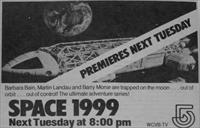
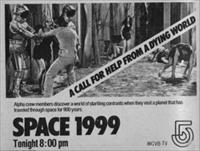
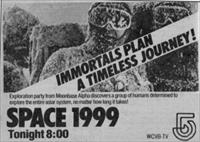
Newspaper promotions by WCVB-TV, Boston, Massachusetts
Several new prime time series from the networks in 1975 were flops. Monday at 8pm was particularly weak, with William Shatner's Barbary Coast on ABC, and The Invisible Man on NBC (against 2 popular sitcoms on CBS, Rhoda and Phyllis). ABC and NBC affiliates often replaced these shows with Space: 1999. Both network shows were cancelled by January 1976. Another weak slot was Thursdays 8pm, when NBC had a new but widely disliked sitcom, The Montefuscos (against The Waltons on CBS and Barney Miller on ABC). The weakest show on CBS was Three for the Road on Sundays 7pm (against The Swiss Family Robinson on ABC and The Wonderful World of Disney on NBC).
Often on weekends, Space: 1999 was scheduled early, prior to network prime-time, in a 6pm or 6:30pm slot. On weekdays it sometimes also took an early 7pm slot, used for syndicated shows, before network prime-time began at 8pm. Outside prime-time, stations could fit in more adverts, up from 10 to 15 minutes per hour. Each 50 minute episode would be cut by 5 or more minutes to fit.
The networks still dominated other prime time slots. Top of the ratings were sitcoms, with CBS Monday night being very strong, ABC winning on Tuesdays with Happy Days and a new hit, Laverne and Shirley. Hit family drama series included the 3rd series of The Six Million Dollar Man on ABC Sundays 8pm, with, from January 1976, the 1st series of The Bionic Woman starting on ABC Wednesday 8pm. Grittier police dramas were still strong in 9pm slots, which Space: 1999 didn't threaten: Kojak on CBS Sundays, The Streets of San Francisco on ABC Thursdays, and the first series of Starsky and Hutch on ABC Wednesdays (at 10pm).
Overall the marketing was a success. The series being sold in 155 cities of which 88 pre-empted network programming. 96% of the homes with television in the U.S. were able to see the series.
The audience reaction is measured through rating (percentage of total adults) and share (percentage of adults watching TV at the time). See this BackStage article). The two major markets were New York and Los Angeles.
The series failed in some local markets (usually when placed against the popular Lawrence Welk music show). The demographic breakdown of the ratings was especially strong, with the series consistently in the top slot for 18-49 year-old men and women. After some twelve weeks the popularity was to decline, though remaining respectable.
Critical reaction was mixed, but the series was evidently a hit.
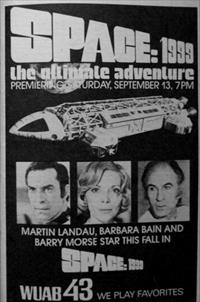
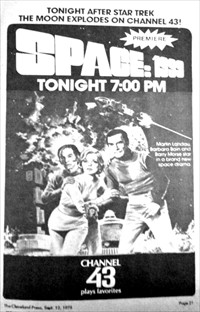
WUAB channel 43 in Cleveland Ohio, adverts in TV Guide (left) and Cleveland Press (right) for 13 September 1975 premiere at 7pm. The Gray Morrow artwork for Charlton comics was widely used in adverts.
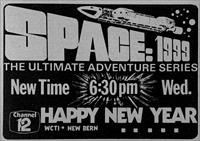
On December 15th, 1975, ATC issued a press release:
Sir Lew Grade announced that due to the extraordinary success of Space: 1999 in the United States and the rest of the world, we have decided to make another series of twenty four one hour episodes. The production will commence at Pinewood Studios in the middle of January 1976.
In a huge advertisement in Variety on Wednesday, January 28th 1976, ITC claimed that within twenty four hours of that announcement, renewals poured in from stations representing 42.7 per cent of total US TV homes, plus 68 countries around the world, including Canada's CBC network
. They also reprinted press praise and noted they had so far received 256,607 fan letters.
An ITC spokesman commented "Frankly, we're hoping for a network to pick up the show for a second season." ITC seems to have believed they could attract a network sale, especially with a new American producer, Fred Freiberger. Unfortunately they were wrong. Again, they were forced to sell the series to individual stations.
ITC began to distribute a "Network News" newsletter to the stations, advising of marketing campaigns and events and supplying promotional material. The first noted that 171 merchandising licenses had been granted, while the second reported that a videocassette of Breakaway had been included in a Bicentennial time capsule buried in Kauai, Hawaii, for the Tricentennial year of 2076. Nick Tate was invited to the Maryland University "August Party", a Star Trek fan convention, and arrived in late July to include it in a publicity tour through New York, Baltimore and Washington. Tate gave many local and national press, radio and television interviews, including one luncheon in New York for editors of science fiction magazines, preceded by a showing of The Metamorph.
In July and August, several stations broadcast a "sneak preview" of The Metamorph (in a slightly different edit to the final cut). One of the first was WVTV-18 Milwaukee on Wed 14 July 1976 at 7pm. Other stations scheduled against television coverage of the Republican party convention (Ford vs Reagan, 16-19 August 1976). Among the stations that showed it were WUAB-TV43 in Cleveland, Ohio, at 8pm, Thursday 19th August 1976, and KRON-TV in San Francisco, California on Saturday 21st August 1976 at 10pm.
Brian Johnson and Catherine Schell followed Tate to the US on August 20th, doing press and TV talk shows in New York, Los Angeles and Philadelphia for a week. Transatlantic phone interviews were also being arranged with both of them plus Gerry Anderson, Freddie Freiberger and the Landaus. The Landaus and Catherine Schell did more "personal promos" for individual stations before the second series began in the fall of 1976. The last episodes were still being filmed in Britain.
Uptake of the series was much less than the first series, and stations scheduled it poorly and erratically in non-peak timeslots. The network scheduling for 1976 was stronger, with reliable sitcoms and dramas such as The Six Million Dollar Man on ABC Sundays 8pm and The Bionic Woman on ABC Wednesdays 8pm limiting the weaker slots. New series such as Charlie's Angels starting on ABC Wednesdays being particularly strong. Two marginally science fiction formats failed, Gemini Man on NBC Thursdays 8pm and ABC's sitcom Holmes & Yo-Yo on Saturdays 8pm. ITC's own The Muppet Show also started in syndication, competing for family audiences. Meanwhile, loyal audiences watched episodes that were aggressively cut.
The ratings this time were only luke-warm and the stations were losing interest. An additional thirteen episodes were proposed to start filming in summer 1977, but the cast and crew had dispersed and the market response was too weak to justify a third series. The series was cancelled, ironically as the science fiction boom began with Star Wars.
From September 1976, a number of toy companies launched TV commercials in the major US markets:
In the 1990s the series appeared again on the cable Sci-Fi Channel, each episode ruthlessly edited.
City |
State |
Original Station (1975-7) |
Regular timeslot |
|---|---|---|---|
Albuquerque |
New Mexico |
KOB-TV (NBC) |
|
Asheville |
North Carolina |
WLOS-TV (ABC) |
|
Atlanta |
Georgia |
WXIA-TV (ABC) |
|
Bakersfield |
California |
KERO-TV (NBC) |
|
Bangor |
Maine |
WABI-TV (CBS) |
|
Baton Rouge |
Louisiana |
WBRZ-TV (NBC) |
|
Bellingham |
Washington |
KVOS-TV (CBS) |
|
Boise |
Idaho |
KTVB-TV (NBC) |
|
Boston (Y1) |
Massachusetts |
WCVB-TV (Channel 5, NBC) |
Tuesday 8pm, later Friday 7:30pm (?) |
Boston (Y2) |
Massachusetts |
WLVI-TV (Channel 56) |
Sunday 6pm |
Brownsville |
Texas |
KRGV-TV (NBC) |
|
Cedar Rapids-Waterloo |
Iowa |
KCRG-TV (ABC) |
|
Charleston |
West Virginia |
WCHS-TV (Channel 8, CBS) |
Thursday 7pm |
Charlotte |
North Carolina |
WSOC-TV (NBC) |
|
Chicago |
Illinois |
WGN-TV (Channel 9, independent) |
Y1: Started Sunday 5:30pm October 5th, 1975. Shifted to Tues 7pm, then also Thurs 7pm |
Cincinatti |
Ohio |
WXIX-TV (Channel 19, independent) |
Saturday 6pm |
Cleveland |
Ohio |
WUAB-TV (Channel 43, independent) |
Saturday 7pm starting 13 September 1975 (premiere earned a 32% share; repeated Sunday 14 September at 12 noon) |
Columbia |
South Carolina |
WIS-TV (NBC) |
|
Dayton |
Ohio |
WKEF-TV (ABC) |
|
Decatur |
Illinois |
WAND (ABC) |
|
Denver |
Colorado |
KMGH-TV (CBS) |
|
Detroit |
Michigan |
WKBD-TV (Channel 50, independent) |
Sunday 6:30pm |
El Dorado |
Arkansas |
KTVE (ABC) |
|
El Paso |
Texas |
KDBC-TV (NBC) |
|
Elkhart |
Indiana |
WSJV-TV (ABC) |
|
Eugene |
Oregon |
KVAL-TV (NBC) |
|
Evansville |
Indiana |
WTVW-TV (ABC) |
|
Flint |
Michigan |
WJRT-TV (ABC) |
|
Fort Myers |
Florida |
WEVU-TV (ABC) |
|
Fort Pierce |
Florida |
WTVX-TV (CBS) |
|
Fort Wayne |
Indiana |
WPTA (ABC) |
|
Fresno |
California |
KFSN-TV (CBS) |
|
Greensboro |
North Carolina |
WFMY-TV (CBS) |
|
Honolulu |
Hawaii |
KITV (ABC) |
|
Indianapolis |
Indiana |
WLWI/WTHR-TV (Channel 13, ABC) |
Sunday 11am and Monday 12:15am |
Jacksonville |
Florida |
WTLV (NBC) |
|
Jefferson City |
Missouri |
KRCG-TV (CBS) |
|
Joplin |
Missouri |
KUHL-TV (CBS) |
|
Kansas City |
Missouri |
WDAF-TV (NBC) |
|
Kearney |
Nebraska |
KHGI-TV (ABC) |
|
Knoxville |
Tennessee |
WATE-TV (NBC) |
|
Las Vegas |
Nevada |
KORK-TV (NBC) |
|
Lexington |
Kentucky |
WTVQ-TV (ABC) |
|
Los Angeles |
California |
Saturday 7pm starting 23 August 1975 |
|
Louisville |
Kentucky |
WAVE-TV (NBC) |
Year 1 only |
Lubbock |
Texas |
KMCC-TV (ABC) |
|
Miami |
Florida |
WTVJ-TV (CBS) |
From Wednesday 10 September 1975 7pm |
Milwaukee |
Wisconsin |
WVTV-TV (Channel 18, indepedent) |
Sunday 5pm |
Monterey |
California |
KMST (CBS) |
|
Nashville |
Tennessee |
WNGE-TV (Channel 2, ABC) |
Saturday 10:30pm |
New Bern |
North Carolina |
WCTI-TV (ABC) |
From New Year 1976, Wed 6:30pm |
New Haven |
Connecticut |
WTNH-TV (ABC) |
|
New Orleans |
Louisiana |
WDSU (Channel 6, NBC) |
Saturday 4:30pm |
New York City |
New York |
Saturday 7pm (Year 1) starting 20 September 1975 |
|
Norfolk |
Virginia |
WAVY-TV (NBC) |
|
Oklahoma City |
Virginia |
KOCO-TV (ABC) |
|
Omaha |
Nebraska |
WOW-TV (CBS) |
|
Orlando |
Florida |
WDBO-TV (CBS) |
|
Peoria |
Illinois |
WRAU (Channel 19, ABC) |
Thurs 7pm until mid Dec 75 |
Philadelphia |
Pennsylvannia |
WPVI-TV (Channel 6, ABC) |
Friday 7pm |
Phoenix |
Arizona |
Saturday 6pm starting 13 September 1975 |
|
Pittsburgh |
Pennsylvannia |
WPGH-TV (Channel 53, independent) |
Sunday 6pm |
Plattsburgh |
New York |
WPTZ-TV (NBC) |
|
Portland |
Oregon |
KATU-TV (ABC) |
|
Providence |
Rhode Island |
WJAR-TV (Channel 10, NBC) |
Sunday 3pm |
Rochester |
Minnesota |
KROC-TV (NBC) |
|
Rock Island |
Illinois |
WHBF (Channel 4, CBS) |
Tues 7pm until mid Dec 75 |
Sacramento |
California |
Saturday 6:30pm starting 13 Sept 1975 |
|
Salt Lake City |
Utah |
KCPX-TV (ABC) |
|
San Antonio |
Texas |
KSAT-TV (ABC) |
|
San Diego |
California |
KGTV (NBC) |
|
San Francisco |
California |
Breakaway only: 10pm Friday 5 September 1975 |
|
Sioux City |
Iowa |
KTIV (NBC) |
|
Sioux Falls |
South Dakota |
KELO-TV (CBS) |
|
Spokane |
Washington |
KHQ-TV (NBC) |
|
Springfield |
Massachusetts |
WWLP (NBC) |
|
Syracuse |
New York |
WNYS-TV (ABC) |
|
Tampa (Y1) |
Florida |
Breakaway only: 8pm Friday 5 September |
|
Tampa (Y2) |
Florida |
WTOG (Channel 44, independent) |
Sundays 6pm |
Toledo |
Ohio |
WOHO (ABC) |
|
Tucson |
Arizona |
KVOA-TV (NBC) |
|
Washington DC |
DC |
WMAL-TV (Channel 7, ABC) |
Saturday 7pm starting 13 Sept 1975 |
See TV Guide covers
Copyright Martin Willey
CBS and US network TV
Of the three US TV networks, CBS, was most regularly top of the ratings.
The president of CBS, Robert D. Wood (1925-1986), had taken over the company in 1966 and ran it until 1976. Wood's biggest success had been reworking a British comedy (Til Death Us Do Part, 1965-1975) into an American version (All In The Family, 1971-1979). Another early success had been Mission Impossible, and CBS had been so keen on the co-star Martin Landau that they directly paid his salary for the 1967 and 1968 seasons, instead of production company Desilu (see more). In July 1973, Abe Mandell of ITC and Gerry Anderson had pitched their science fiction series to all three US networks, including CBS. Landau and Bain were on their list of actors to interview in Los Angeles, and CBS warmly welcomed their names headlining the series. They also wanted American directors and American writers.
There was not a contract with CBS, and while ITC publicity there was no mention of CBS. In March 1973 CBS had shown the science fiction pilot Genesis II, produced by Gene Roddenberry, and a 20-episode series was in early development. It is likely the Roddenberry and Anderson series were in competition for a CBS slot in September 1974. ITC felt confident enough to move into production, assuming that if CBS passed, the other networks would pick it up.
On 14 September 1973, the original 1968 Planet of the Apes film was shown for the first time on US TV, after CBS paid a record $1 million. It was a ratings hit with 57% audience share. In October 1973, CBS reached an agreement with 20th Century Fox to produce a Planet of the Apes TV series for September 1974. Both Genesis II and Space: 1999 were no longer of interest to CBS. CBS president Robert Wood stated "We only want one science fiction series on our network at a time."
See more on US TV, specifically for Star Trek and Mission: Impossible.